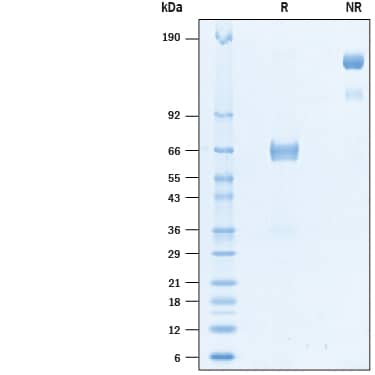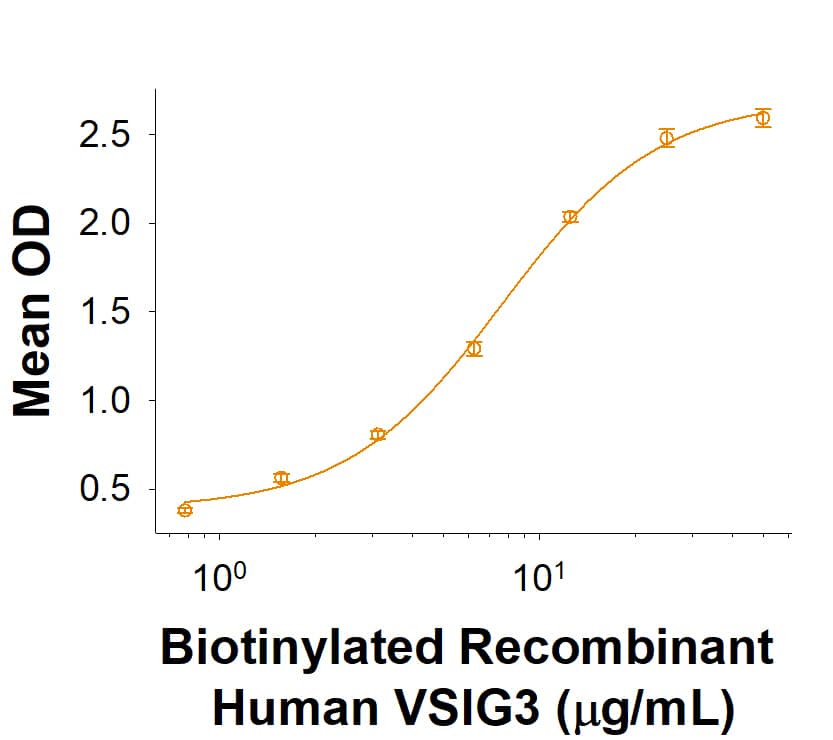Recombinant Human VSIG3 Fc Chimera Biotinylated Protein, CF
R&D Systems, part of Bio-Techne | Catalog # BT9229

Key Product Details
Source
NS0
Accession #
Structure / Form
Disulfide-linked homodimer, biotinylated via amines.
Conjugate
Biotin
Applications
Bioactivity
Product Specifications
Source
Mouse myeloma cell line, NS0-derived human VSIG3 protein
| Human VSIG3 (Leu23-Gly245) Accession # BAC07546.1 |
IEGRMD | Human IgG1 (Pro100-Lys330) |
| N-terminus | C-terminus |
Purity
>95%, by SDS-PAGE visualized with Silver Staining and quantitative densitometry by Coomassie® Blue Staining.
Endotoxin Level
<0.10 EU per 1 μg of the protein by the LAL method.
N-terminal Sequence Analysis
Leu23
Predicted Molecular Mass
50 kDa
SDS-PAGE
56-69 kDa, under reducing conditions
Activity
Measured by its binding ability in a functional ELISA.
When Recombinant Human VISTA/B7-H5/PD-1H Fc Chimera Protein (Catalog # 7126-B7) is immobilized at 2.5 μg/mL (100 µL/well), the concentration of Biotinylated Recombinant Human VSIG3 Fc Chimera Protein (Catalog # BT9229) that produces 50% of the optimal binding response is found to be approximately 2-10 µg/mL.
Measured by its ability to inhibit anti-CD3 antibody induced IL-17 or IFN-gamma secretion by human peripheral blood mononuclear cells (PBMC).
The ED50 for this effect is 2-10 μg/mL.
When Recombinant Human VISTA/B7-H5/PD-1H Fc Chimera Protein (Catalog # 7126-B7) is immobilized at 2.5 μg/mL (100 µL/well), the concentration of Biotinylated Recombinant Human VSIG3 Fc Chimera Protein (Catalog # BT9229) that produces 50% of the optimal binding response is found to be approximately 2-10 µg/mL.
Measured by its ability to inhibit anti-CD3 antibody induced IL-17 or IFN-gamma secretion by human peripheral blood mononuclear cells (PBMC).
The ED50 for this effect is 2-10 μg/mL.
Scientific Data Images for Recombinant Human VSIG3 Fc Chimera Biotinylated Protein, CF
Recombinant Human VSIG3 Fc Chimera Biotinylated Protein Binding Activity
When Recombinant Human VISTA/B7-H5/PD-1H Fc Chimera Protein (Catalog # 7126-B7) is immobilized at 2.5 µg/mL (100 µL/well), the concentration of Biotinylated Recombinant Human VSIG3 Fc Chimera Protein (Catalog # BT9229) that produces 50% of the optimal binding response is found to be approximately 2-10 µg/mL.Recombinant Human VSIG3 Fc Chimera Biotinylated Protein SDS-PAGE
2 μg/lane of Biotinylated Recombinant Human VSIG3 Fc Chimera (Catalog # BT9229) was resolved with SDS-PAGE under reducing (R) and non-reducing (NR) conditions and visualized by Coomassie® Blue staining, showing bands at 56-69 kDa and 110-140 kDa, respectively.Formulation, Preparation and Storage
BT9229
| Formulation | Lyophilized from a 0.2 μm filtered solution in PBS with Trehalose. |
| Reconstitution | Reconstitute at 200 μg/mL in PBS. |
| Shipping | The product is shipped at ambient temperature. Upon receipt, store it immediately at the temperature recommended below. |
| Stability & Storage | Use a manual defrost freezer and avoid repeated freeze-thaw cycles.
|
Background: VSIG3
References
- Schreiber, J. et al. (2014) Adv. Neurobiol. 8:21.
- Suzu, S. et al. (2002) Biochem. Biophys. Res. Commun. 296:1215.
- Katoh, M. and M. Katoh (2003) Int. J. Oncol. 23:525.
- Raschperger, E. et al. (2004) J. Biol. Chem. 279:796.
- Harada, H. et al. (2005) J. Cell. Physiol. 204:919.
- Jang, S. et al. (2016) Nat. Neurosci. 19:84.
- Watanabe, T. et al. (2005) Cancer Sci. 96:498.
- Eom, D.S. et al. (2012) PLoS Genet. 8:e1002899.
Long Name
V-Set and Immunoglobulin Domain Containing 3
Alternate Names
BTIGSF, CXADRL1, IGSF11
Gene Symbol
IGSF11
UniProt
Additional VSIG3 Products
Product Documents for Recombinant Human VSIG3 Fc Chimera Biotinylated Protein, CF
Product Specific Notices for Recombinant Human VSIG3 Fc Chimera Biotinylated Protein, CF
For research use only
